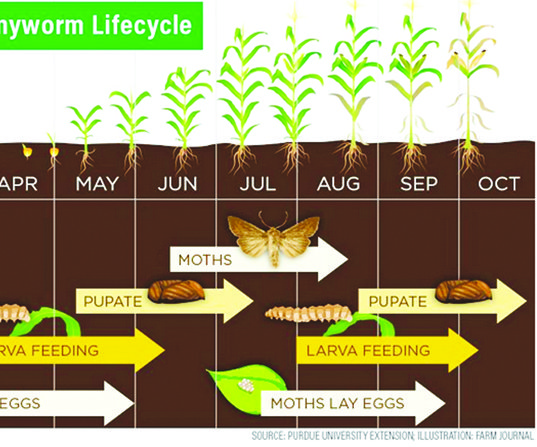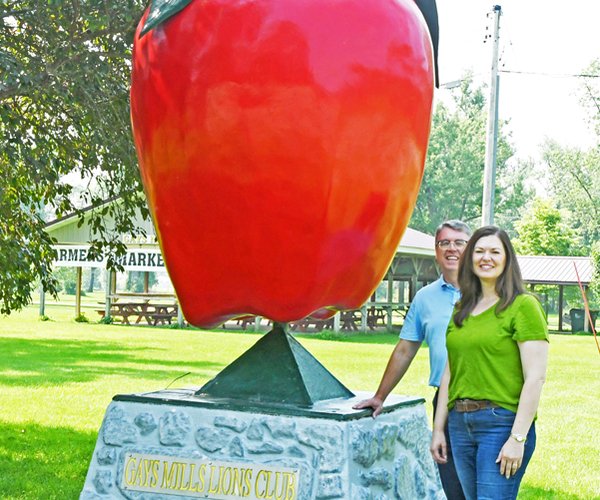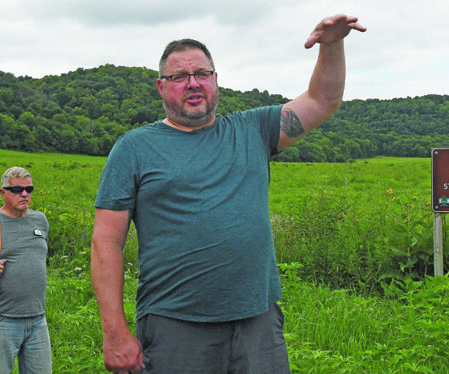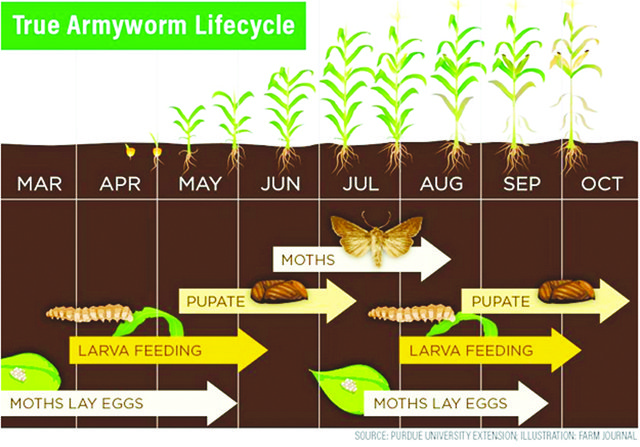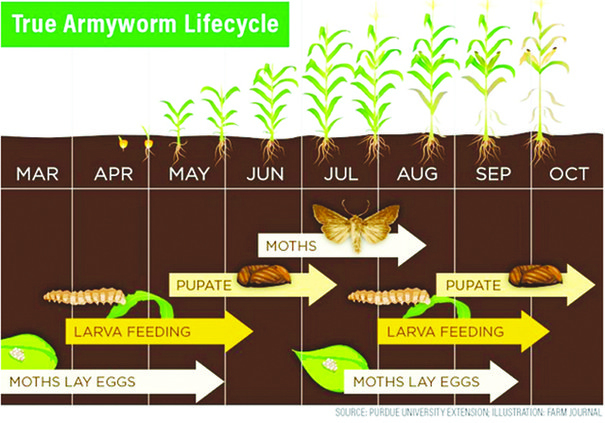Late last week, new broke of an infestation of second-generation true Army Worms affecting certain crop fields in Southwest Wisconsin. What caught the Independent-Scout’s attention was that the initial report said a field near Steuben had been affected. Since, we’ve learned there’s been another field affected outside of Seneca, and scattered reports of the pest in Vernon and Monroe counties.
The DATCP press release read as follows:
“Second-generation true armyworm activity has been reported in several Wisconsin counties, prompting a scouting advisory for crop advisors and farmers. Damaging populations of larvae were observed in the Highland area of western Iowa County on July 18 and near Steuben in Crawford County on July 20. According to a regional agronomist, infestations of six to eight armyworms per square foot with severe leaf feeding were observed in sorghum and sorghum-sudangrass hybrids.
“Additional sightings in Columbia, Dane, Dunn, Jefferson, and Taylor counties have been reported to PJ Leisch at the UW-Madison Insect Diagnostic Lab. The infestation near Boyceville in Dunn County was particularly heavy and included a video of armyworm larvae migrating across a road and toward a cornfield.
“Although armyworm outbreaks are unpredictable, the localized activity observed this week in Columbia, Crawford, Dane, Dunn, Iowa, Jefferson, and Taylor counties may be representative of a larger outbreak. The timing of the infestations corresponds with significant moth flights tracked by DATCP’s True Armyworm Trap Network about three weeks ago, and large July flights could lead to more larvae and feeding extending well into August. Scouting for armyworm larvae should begin as soon as possible.”
Chris Olson of Olson Feed Service in Seneca confirmed the two fields of Sorghum-Sudan affected in Crawford County.
“While there can be some corn damage, often it affects only the lower leaves of the corn plant, which likely won’t affect the crop,” Olson said. “Spraying isn’t necessarily the best answer, and can kill a lot of the beneficial bugs that we don’t want to kill. Deciding whether or not to spray sort of depends on the life cycle of the bug.”
Olson said it’s more typical to see the “true army worm” variety of the bug in the late spring. He said they’re often seen in planted fields that have been sprayed with an herbicide, where the weeds are dying. He said that an infestation of second generation bugs later into the summer is less common.
“The main thing with deciding whether or not to spray is to take the time to evaluate the life cycle of the bug, and the impact the damage will have on your crop before deciding to spray,” Olson said.
Vernon/Monroe
Brad Robson, Hornby Hollow crop and beef farmer, and Conservation Agronomist with the Monroe County Land Conservation Department, shared his observations of Army Worm activity in Vernon and Monroe counties.
“I’ve observed two-to-three infestations in Monroe County, and talking with Berent Froiland of Chaseburg Supply Cooperative, he’s heard of three-to-four pockets in Vernon County,” Robson said. “Once the Army Worms get to their second generation, then they’re done for the year because they only have two hatches. The bugs don’t overwinter this far north, so they have to be blown in to be seen this far north.”
Robson said the bugs are attracted to grassy pastures or hay fields, including alfalfa, or to cover crops such as sorghum-sudan. He said he’d also observed Army Worms migrating from a cornfield into a neighboring lawn, and “the lawn looked like it had gone through a terrible drought.”
“The first generation isn’t usually as bad, which is why we often don’t catch it,” Robson said. “But the good news is they only have two hatches, and then they’re done.”
Robson said that often producers aren’t very well informed about Army Worms because infestations aren’t that common in this area.
“If you catch it at the right time, spraying could help, but once they get to be about three-quarters-of-an-inch long, then you can’t stop them with the spray,” Robson said. “At that point, spraying would likely just be throwing good money after bad, and would also kill the beneficial insects that we don’t want to kill.”
Army Worms
According to the UW-Extension Division of Crops and Soils web page, “True armyworm (Mythimna unipuncta) is a pest of corn and small grains known for migrating in large groups when its preferred food source is depleted. The adult moths lay their eggs in lush, green grasses, and the larvae primarily feed on grasses, especially barley, corn, oats, rye and wheat. Pastures and grassy hay fields are also at risk of damage.”
“True armyworm eggs are small, greenish-white, and spherical. They are laid in rows or clusters on lush, green grasses. The eggs darken before hatching. The larvae range from brownish-green to black, with orange, brown, and white stripes running lengthwise on the sides. Dark and light stripes alternate along their backs. The head is light brown with dark markings. Full-grown larvae are about 2.0 inches long. True armyworm pupae are dark brown and about 0.75 of an inch long. The adult moths are beige with a wingspan of about 1.5 inches. The moths are identifiable by a distinctive white dot in the center of each forewing.
“Armyworms do not overwinter in Wisconsin. Instead, the moths migrate from the milder climate of the southern United States and northern Mexico, returning each spring with weather systems. The Wisconsin Department of Agriculture, Trade and Consumer Protection (DATCP) tracks the timing of true armyworm arrival and moth flights in Wisconsin through its True Armyworm Monitoring Network.
“Starting in April, they produce two or three generations per season in Wisconsin. Each larval generation lasts five to six weeks. The first generation is usually small but can cause economic damage to wheat and corn planted after grass cover crops. A successful first generation may also give rise to an even more destructive second generation of larvae. The second generation of larvae in July is typically the largest and most damaging.
“True armyworm moths are nocturnal and lay their eggs in the evening on leaf blades of their host plants. The eggs hatch after seven to 10 days, and the larvae then feed on corn and wheat foliage, as well as grass in hay fields or pastures, for about 25 days. Armyworm larvae develop through six instars before pupating for approximately 14 days and emerging as moths.
“True armyworms feed at night or on cloudy days on the leaf tissue of plants. In severe cases, true armyworm larvae can entirely strip the leaves.
“First-generation armyworm infestations in June can be found by scouting field margins for corn leaves with ragged edges. The irregular, ragged chewing pattern along the leaf edge is a telltale sign of armyworm feeding. Closely check corn plants for larvae and frass in the whorls. Also pay attention to lodged areas of wheat and small grains fields.
“Second-generation infestations in July may occur throughout a corn field if grassy weeds (e.g., foxtails, quackgrass, and nutsedge) are abundant in between rows for egg laying. Signs of feeding include plants with ragged leaves or brown frass, and the larvae can often be found inside the whorl or leaf axils. Damage is usually highest along field edges or in grassy spots. In wheat and other small grains, the larvae feed on grassy weeds and on the leaves of host plants and may clip off the grain heads. The larvae are difficult to detect and hide in crop debris on the ground or under soil clods, particularly in lodged areas of small grains fields.
“The threshold for treatment of true army worm for corn is 25% of plants with two larvae (less than 0.75 inch long) or 75% of plants with one larva. In small grains, the threshold is three larvae per square foot. Spot treat only the border rows when possible.
“Treatment thresholds are not based on moth flights. DATCP’s True Armyworm Monitoring Network provides updates on true armyworm moth migration and captures across the state. This information is used to determine the arrival of true armyworm in Wisconsin and to forecast the optimal time to scout for larvae.”
Household lawns
An early sign of a potential army worm infestation in a lawn is brown patches that may resemble drought damage, with chewed or ragged grass blades. Visible caterpillars, especially during early morning or late afternoon, and increased bird activity (pecking at the lawn) can also indicate an army worm presence.
The most effective ways to eliminate army worms involved a combination of preventative measures and targeted treatments. These include insecticides, encouraging beneficial insects, and maintaining healthy turf to minimize attractive conditions.
Insecticides applied to an infestation include those with active ingredients like bifenthrin, cyfluthrin, cypermethrin, lambda-cyhalothrin, permethrin, or spinosad (an insect control product approved for use in organic production). For best results, apply either in the early morning or late evening when army worms are most active.
Beneficial insects such as stink bugs, big-eyed bugs, rove beetles, tachinid flies and parasitic wasps prey on army worms. Beneficial nematodes can also be purchased and applied to soil to help control army worms.
Handpicking for small infestations is also an option. The bugs should be hand-picked, and placed into a bucket of soapy water.


